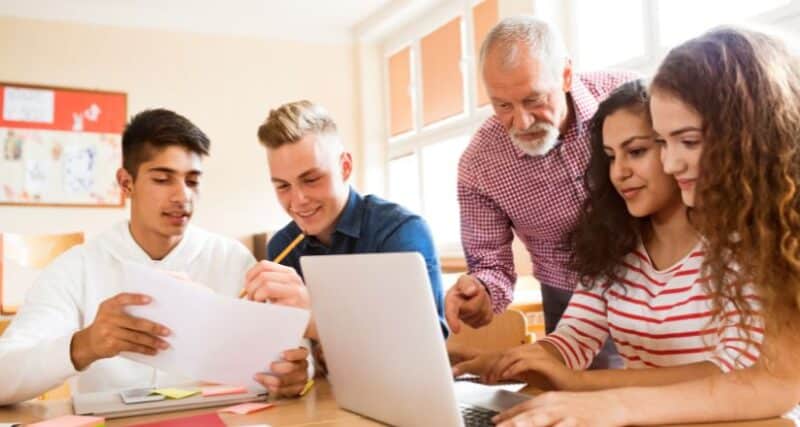Level Up Your Teaching by Creating these Powerful Moments in the Classroom
Back in September of 2019 I was at a conference for instructional coaches, and a coach from a local career and technical education center told me about their professional development plan for the year. They were going to have the whole faculty read the book The Power of Moments by Chip and Dan Heath; the book is broken into 4 parts, which would fit nicely into the 4 quarters of the school year. Each part of the book was about a different type of moment, and the teachers were going to work together to figure out ways to create the types of moments in their classrooms. It sounded amazing, and we bought a few copies of the book at my school hoping we might infuse it into PD in the future.
Then the pandemic hit, and switching first to virtual and then to hybrid teaching consumed all of our PD time for the next two years. This spring I found The Power of Moments sitting on my bookshelf at school and decided to finally give it a read. I’m so grateful that I did. The book is interesting and thought-provoking and inspiring…all the things you want a book to be. I read it in just a few days and now firmly believe it is a great book to inspire some professional growth in the coming weeks.
The book opens with the story of Chris Baric and Donald Kamentz, two teachers at YES Prep Academy in Houston, Texas. This was a school where 90% of their seniors were the first in their families to go to college, and one of the requirements for graduation was to be accepted to a college or tech school. Students didn’t need to attend but at least be accepted. Back in 2000 these two educators were having dinner at a sports bar, and ESPN was on the TV showing National Signing Day for football players. It made Chris ask himself a question: How can we create a moment for academic achievement as exciting as the moments we create for athletic achievement? That day the idea for a Senior Signing Day, where students and families gather to watch seniors announce college or tech school acceptance, was born. It was an event that became part of the fabric of the school’s culture and created lasting memories for all involved.
And lasting memories are really what it is all about. On page 9 the authors write, people “tend to remember flagship moments: the peaks, the pits, and the transitions.” The challenge the book presents to educators is how can we intentionally craft units of study that contain “peak” moments that will stand out in students’ memories? How can we build moments that they will remember for years? Can you remember any such moments from your own education?
As previously stated, the book describes 4 types of moments: moments of elevation, moments of insight, moments of pride, and moments of connection. For each moment, I will first outline what it is and then offer specific examples of what the moment can look like in a classroom (elementary through secondary). I want to challenge teachers to pick just one moment and make a plan for how to infuse that moment into a unit of study for this upcoming school year. Imagine if you did this each summer. After 10 summers, you will have created 10 powerful moments students will remember for years to come!
Moments of Elevation
On page 13 it states, “moments of elevation transcend the normal course of events; they are literally extraordinary.” Essentially, moments of elevation break the normal routine and contain an element of surprise. To create such moments, the authors offer three tips: 1) Boost sensory appeal; 2) Raise the stakes; 3) Break the script. Let’s look at an example of an interdisciplinary project outlined in the book that did all three.
Back in 1989, a California high school English teacher realized that their 10th grade students were simultaneously reading The Lord of the Flies by William Golding in English 10 while studying World War II in World History with his colleague. Golding wrote the book as a comment on human nature while witnessing the horror of what was happening in Europe during WWII. Why were the students reading the book and studying about the war in isolation? The teachers decided to team up and create a project called The Trial of Human Nature where students were asked to put William Golding on trial. Was he right about human nature being violent and defective or was he misrepresenting human nature in his book? Students were assigned roles of lawyers, witnesses, and judges. The witnesses could be any figures from history that they had learned about. Parents were invited to attend the trial (that’ll raise the stakes!). As you can imagine, student learning went much deeper than had occurred previously, and students and parents were left with lasting memories of the trial.
Does creating a moment of elevation mean having to create a large, multi-week project? Absolutely not. It could mean simply adding an element of surprise to an existing lesson. For example, my daughter’s 5th grade teacher decided to shake up a lesson on researching by having students pick a plant from the school’s garden to research and write a paragraph about. They then generated QR codes to put in the garden so people could scan them and learn about the plants. The best thing about this lesson? The whole thing happened outside in the garden. My daughter came home so excited that she got to spend part of her day learning in the garden. Learning outdoors or in an unexpected location is a great way to create a moment of elevation. Check out this Edutopia video that shows how this can be done even with our littlest learners.
And you also don’t have to move locations to create surprising moments of elevation. Simply making a lesson more sensory or hands-on in unexpected ways can lead to deeper learning and just plain old fun. Check out this video that shows how one middle school math teacher strives to make her Geometry lessons more hands-on so students can visualize and remember math concepts.
Moments of Insight
Moments of insight are described as moments that “rewire our understanding of ourselves or the world.” (13) These moments help us see something in a completely new way. Chapter 5 explains that the goal is to get students to “trip over the truth.” Check out this video by author Dan Heath as he explains in more detail what tripping over the truth means. In summary, it’s when we lead students to come to a new understanding on their own. We don’t just give them the information; we create an experience that lets them stumble upon it. This concept is a cornerstone of experiential education.
Years ago I knew a teacher who crafted an amazing experience to get students to trip over the truth of how impactful the battle of Gettysburg was in his American History class. He was frustrated with just giving the facts about a battle, with students taking notes and looking at photos. He wanted to find a way to have them experience, in a more visceral way, just how violent and devastating the battle was. An estimated 51,000 lives were lost; the most of any battle during the Civil War. To help students fully realize just how many people that is, he scrounged together 51,000 metal BB gun bullets with the help of multiple teachers and students. On the day he taught about Gettysburg, he started the lesson by telling them that 51,000 people had died and then slowly poured jars of bullets into a big metal stockpot to illustrate how many people that was. The sound in his room was deafening, and it took minutes to pour all of the bullets out. By the time he was done, many of the students were uncomfortable. They understood the truth that there were so many people lost! Years later, students still talked about that lesson.
Another big way to get students to trip over the truth is to let them experiment and lead their own learning. Science teachers do this all the time, but how can teachers in other subject areas infuse experimentation into their lessons? Check out this Edutopia video that demonstrates how it is done in an elementary school in Scotland.
Moments of Pride
Moments of pride celebrate achievement or acts of courage. Many schools are good at doing larger events to celebrate school pride (assemblies, read-a-thons, pep rallies, etc.), but how often are teachers crafting moments of pride within the classroom? And what are the most effective ways to instill pride? On page 139, the authors argue that “regardless of how skilled we are, it’s usually having our skill noticed by others that sparks the moment of pride.” Basically, it’s about recognition. In fact, one of the top reasons people cite for leaving jobs is a lack of recognition for what they do. The same can be said for our students in school; a big de-motivator in a class is not being recognized when they take chances or stretch themselves or do a good job.
But the authors also warn that creating generic or formulaic reward programs like “Student of the Month,” though well-intentioned, are often not super effective. Not every kid gets to be student of the month, and the same kids tend to be chosen over and over. They stress to instead make recognition more spontaneous and personal.
In my former school I knew two Cosmetology instructors who did this really well. They had a postcard system where, whenever they noticed a student doing something really kind or stretching herself to learn a new skill or persevering through a tough time, they wrote a quick note on a postcard and sent it home. The key was, students could write postcards for their classmates, too. The teachers would review them and send them home too, so both families and the students being recognized could read them. It not only helped students feel seen, but it also helped create a positive classroom environment rooted in kindness and pride.
The book points out that another way to make recognizing students easier is to help students “level up.” This concept comes from video games and is at the core of Steve Kemp’s book Level Up in your Life: How to Unlock the Hero of Your Own Story. Students can use this gaming strategy to help them break down any task they want to complete (or reach any “destination” as Kemp calls it). The example of “leveling up” below appears on page 164:
LEVEL 1: Order a meal in Spanish
LEVEL 2: Have a simple conversation in Spanish
LEVEL 3: Glance at a Spanish newspaper and understand at least one headline
LEVEL 4: Follow the action in a Spanish cartoon
LEVEL 5: Read a kindergarten-level book in Spanish
DESTINATION: Have a full, normal conversation in Spanish with a coworker or classmate
Imagine if we could help students develop “level up” goals to learn specific skills in our classes and then figure out a way to recognize them when they reach their destination (or even when they don’t but keep persevering). Anyone would feel a huge sense of pride in reaching or getting closer to their destination! It could also help motivate some of those students who are otherwise disengaged.
Moments of Connection
Moments of connection are social moments that we share with others. As the authors point out on page 211, “…for groups, defining moments arise when we create shared meaning – highlighting the mission that binds us together and supersedes our differences. We are made to feel united.” This quote implies the group needs to have a shared mission or goal – be “pulling on the same rope” so to speak – and then link the learning back to that shared goal. The book suggests three strategies for making this happen: 1) creating synchronized moments 2) inviting shared struggle 3) connecting to meaning.
If we break these strategies down for teachers, we need to give our whole class or small groups more time to work together, we need to allow students to share their struggles and help each other through them, and we need to connect back to our shared learning goals along the way.
One of my colleagues who teaches high school math is a master at getting his classes to work together and support each other in what he calls “pods.” They start every math unit by going over the main concepts and skills they need to master; this is a key component of mastery based learning and a key way to help students all “pull on the same rope” throughout a unit. They then create a general road map to how they can acquire the skills or understand the concepts, similar to the “leveling up” strategy explained above. Then they break into pods to work through the unit. Sometimes the pods remain the same the entire unit, sometimes they change. He lets them form and reform organically and doesn’t often “force” pod groupings. He does, however, specifically model how students can help classmates within pods when they struggle. This modeling is key: we can’t assume students know how to respond productively to another’s struggle. Students work in pods until they are ready to individually take a mastery check or summative assessment. If they don’t do well on it, they can return to a pod to regroup and try again. Walking into his class, it always amazed me how the class just hummed with activity, with students always clumped together in groups working on problems or a hands-on activity. It felt so supportive and positive. Frankly, it was very different from the math classes I remember from my high school experience.
And besides just creating a more positive and supportive class environment, getting students to connect and work together can lead to a lot of fun. Check out this Edutopia video that demonstrates how one high school ESOL teacher gets her students to connect and speak and have fun in her class, all with the shared goal of helping each other improve their English. Consider how you could use some of these strategies to create more connection and fun within your classes during specific lessons or units of study.
Moments All Around Us
I hope that within all of the specific examples above, you have found something that sparks an idea…something you could use to add a memorable moment into a unit or lesson. That’s the ultimate goal here.
But in closing, I want to offer one final, different reason for reading this book: it opens your eyes to the possibility of moments all around you. Since reading this book, I have been so much more conscious of creating little moments with my own family. The moment can be as simple as a surprise trip to a local ice cream shop for dinner (What!? Ice cream for dinner!?). Or working with my dad to have a story my daughter wrote professionally illustrated and bound. It will be a birthday present to her so she will always have it and be proud of it because it’s a great story! The Power of Moments makes you question whether you are taking the opportunity to create the moments friends and family will remember forever. Years from now, I want to look back and say that I never let the opportunity go to create a moment.
– Megan Panek





